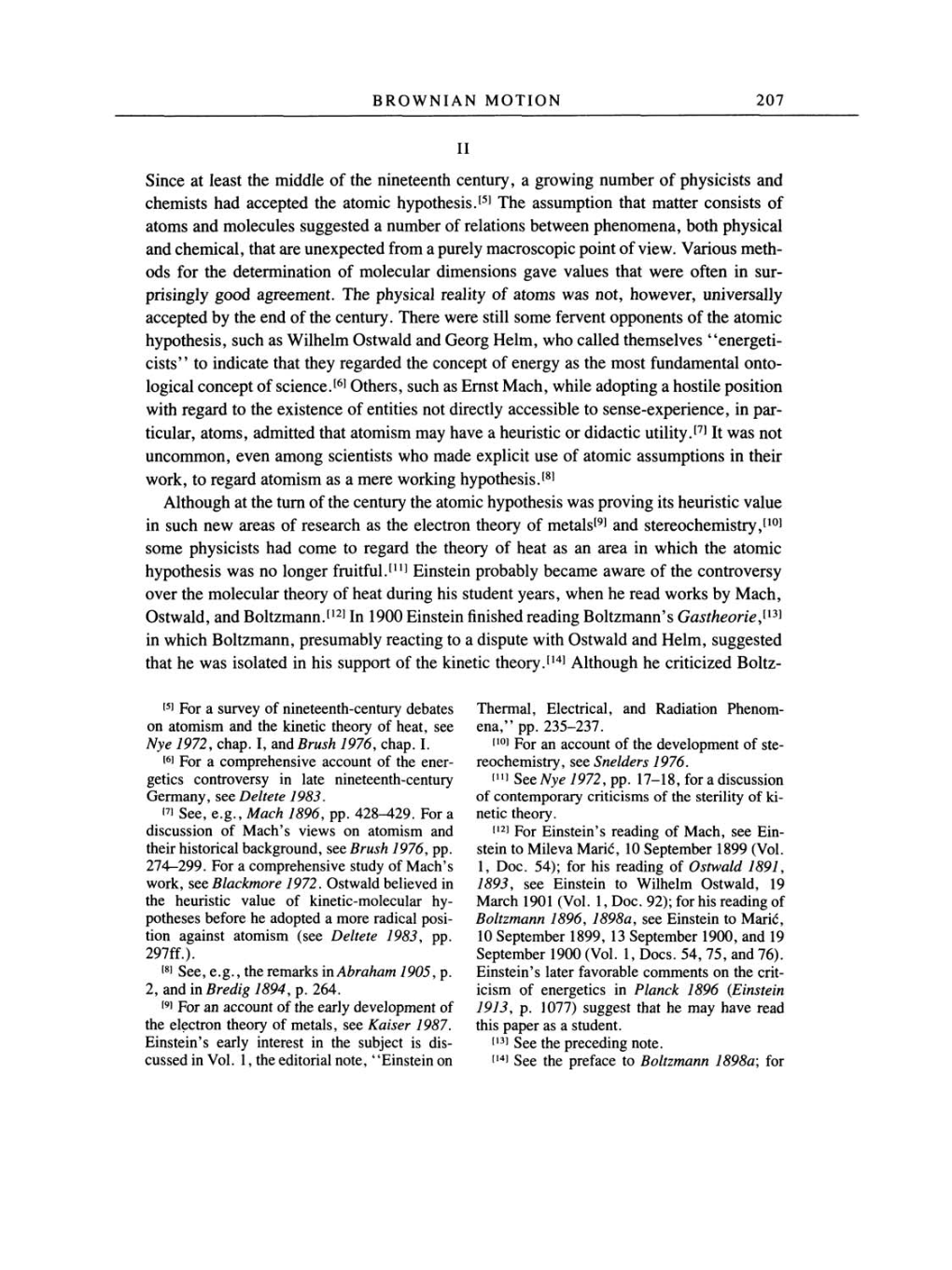BROWNIAN
MOTION 207
II
Since at least the middle
of
the nineteenth
century,
a growing
number of
physicists
and
chemists had
accepted
the atomic
hypothesis.[5]
The
assumption
that matter
consists of
atoms and molecules
suggested a
number
of
relations between
phenomena,
both
physical
and chemical, that
are unexpected
from
a purely macroscopic point
of
view. Various meth-
ods for the determination
of
molecular dimensions
gave
values that
were
often in
sur-
prisingly good agreement.
The
physical reality
of
atoms
was
not, however,
universally
accepted by
the end
of
the
century.
There
were
still
some
fervent
opponents
of
the atomic
hypothesis,
such
as
Wilhelm Ostwald and
Georg
Helm,
who called themselves
"energeti-
cists"
to indicate that
they regarded
the
concept
of
energy as
the most fundamental onto-
logical
concept
of
science.[6] Others,
such
as
Ernst
Mach,
while
adopting a
hostile
position
with
regard
to the existence
of
entities not
directly
accessible to
sense-experience,
in
par-
ticular, atoms,
admitted that atomism
may
have
a
heuristic
or
didactic
utility.[7]
It
was
not
uncommon, even
among
scientists who made
explicit use
of
atomic
assumptions
in their
work,
to
regard
atomism
as a mere
working hypothesis.[8]
Although
at the turn
of
the
century
the atomic
hypothesis
was proving
its heuristic value
in
such
new areas
of
research
as
the
electron
theory
of
metals[9]
and
stereochemistry,[10]
some physicists
had
come
to
regard
the
theory
of
heat
as an area
in which the atomic
hypothesis was
no
longer
fruitful.[11]
Einstein
probably
became
aware
of
the
controversy
over
the molecular
theory
of
heat
during
his student
years,
when he
read works
by
Mach,
Ostwald, and Boltzmann.[12]
In 1900
Einstein
finished
reading
Boltzmann's
Gastheorie,[13]
in which
Boltzmann,
presumably
reacting
to
a
dispute
with Ostwald and
Helm,
suggested
that he
was
isolated in his
support
of
the kinetic
theory.[14]
Although
he criticized Boltz–
[5]
For
a survey
of
nineteenth-century
debates
on
atomism and the kinetic
theory
of
heat,
see
Nye 1972, chap.
I,
and Brush
1976,
chap.
I.
[6]
For
a comprehensive
account
of
the
ener-
getics controversy
in late
nineteenth-century
Germany, see
Deltete 1983.
[7]
See,
e.g.,
Mach
1896,
pp.
428-429.
For
a
discussion
of Mach's
views
on
atomism and
their historical background,
see
Brush
1976,
pp.
274-299.
For
a comprehensive study
of
Mach's
work,
see
Blackmore
1972.
Ostwald
believed in
the heuristic value
of
kinetic-molecular
hy-
potheses
before
he
adopted a more
radical
posi-
tion
against
atomism
(see
Deltete
1983,
pp.
297ff.).
[8]
See, e.g.,
the remarks in Abraham
1905, p.
2, and
in
Bredig 1894, p.
264.
[9]
For
an
account
of
the
early
development
of
the electron
theory
of
metals, see
Kaiser
1987.
Einstein's
early
interest in the
subject is
dis-
cussed in
Vol.
1,
the
editorial
note,
"Einstein
on
Thermal, Electrical,
and Radiation
Phenom-
ena,"
pp.
235-237.
[10] For
an
account
of
the
development
of
ste-
reochemistry,
see
Snelders 1976.
[11]
See
Nye
1972,
pp.
17-18, for
a
discussion
of
contemporary
criticisms
of
the
sterility
of ki-
netic
theory.
[12]
For
Einstein's
reading
of
Mach,
see
Ein-
stein
to
Mileva Maric,
10
September
1899
(Vol.
1,
Doc.
54);
for his
reading
of
Ostwald
1891,
1893,
see
Einstein
to
Wilhelm
Ostwald, 19
March
1901 (Vol.
1,
Doc.
92);
for
his
reading
of
Boltzmann
1896, 1898a,
see
Einstein
to
Maric,
10 September 1899, 13
September
1900, and
19
September 1900
(Vol.
1,
Docs.
54,
75,
and
76).
Einstein's
later
favorable
comments
on
the
crit-
icism
of
energetics
in
Planck
1896
(Einstein
1913,
p.
1077)
suggest
that he
may
have read
this
paper
as a
student.
[13]
See the
preceding
note.
[14]
See the
preface
to Boltzmann
1898a;
for
